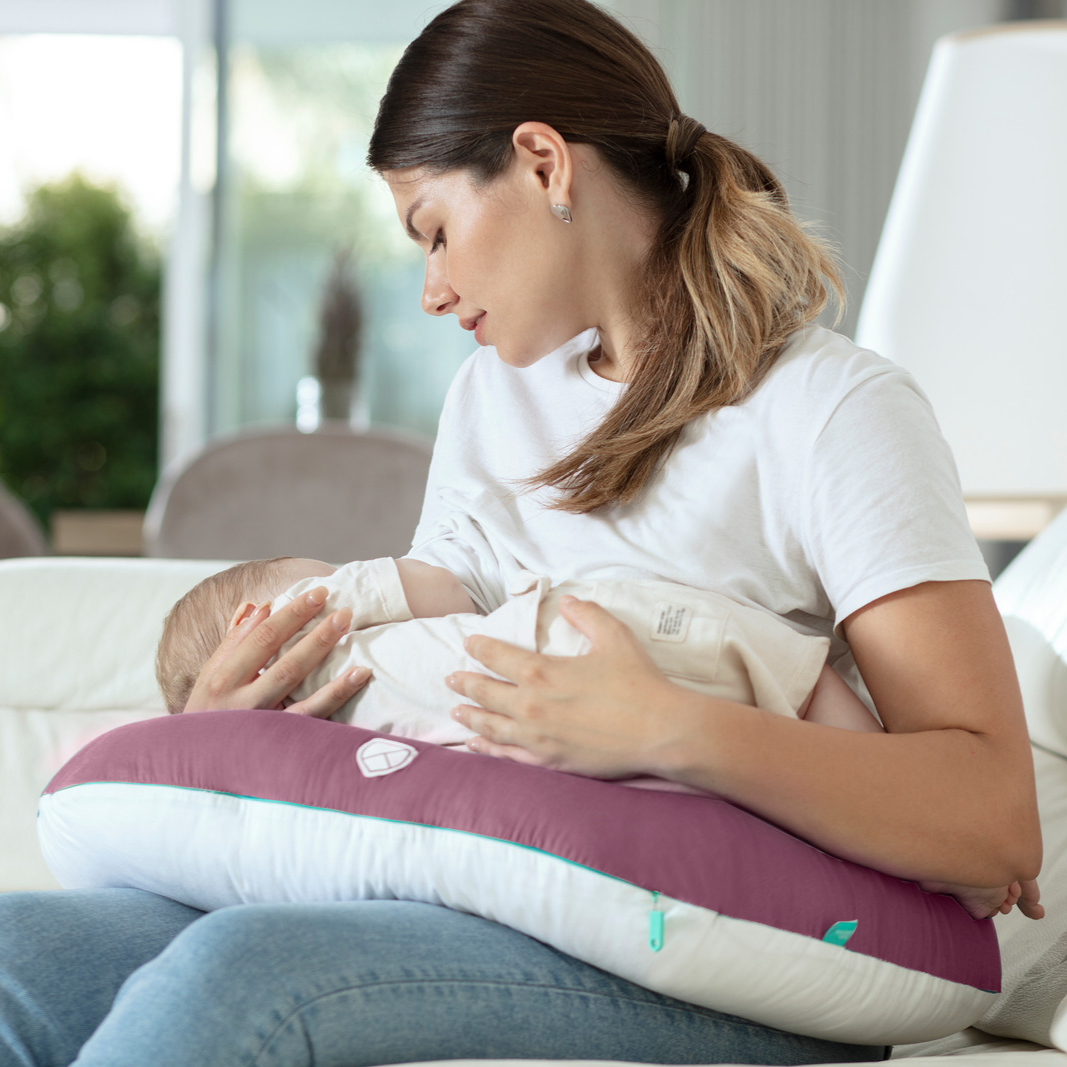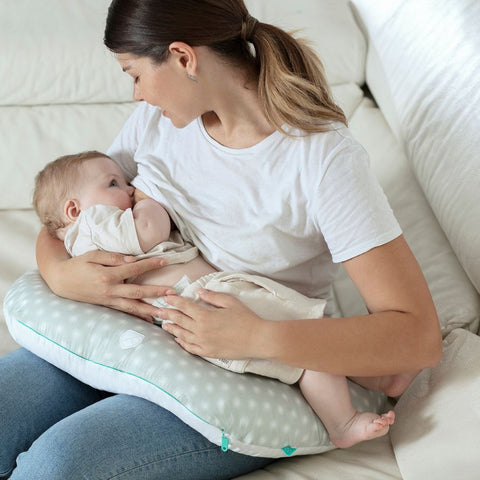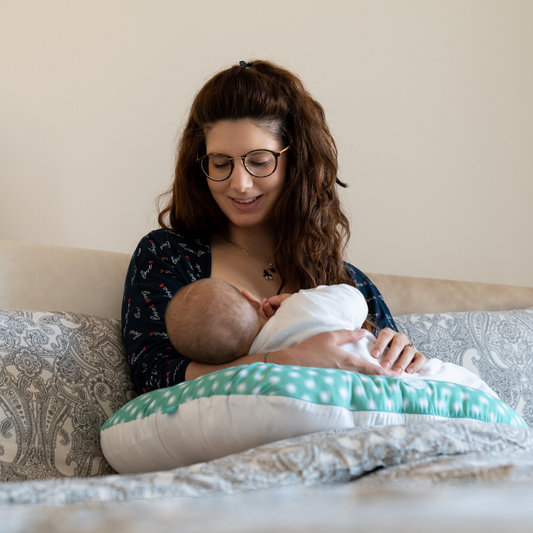How to use a breastfeeding pillow? Why is it important to use one? Which nursing pillow positions can it be used for? We talk about this and more with Valentina De Pietro, Midwife and Breastfeeding Consultant, who offers useful and practical advice as you begin your breastfeeding journey!
Breastfeeding pillow, why use one?
Nursing your child is an intimate time for mum and baby, and tranquillity and comfort are vital.
A feeding pillow offers comfort and makes it a more enjoyable experience for both, as it helps you and your baby adopt the correct position.
It reduces tension in your neck, shoulders, and back area, and can be used right from the first few hours after the birth for that crucial skin-to-skin contact, helping mum feel more relaxed and reducing any tension she feels as she recovers from the birth.
How to use breastfeeding pillow correctly: your baby should be positioned belly to belly with their mum, with their ear, shoulder and hip aligned and the centre of their mouth facing your nipple.
With a nursing pillow you can adopt a variety of different breastfeeding holds, we’ll take a look at positioning for breastfeeding in more detail later. Varying positions is of great importance: it helps to produce more breast milk, prevents engorgement, and helps keep your baby more alert whilst feeding.
Benefits of using a breast feeding pillow
Using a nursing cushion offers many benefits, many more than you might think. Let's take a look at the most significant ones together.
1) Helps mum maintain good posture
Thanks to its anatomical design, it helps mum maintain correct posture with various breastfeeding positions newborn, reducing muscle pain and preventing poor breastfeeding positioning.
It relieves muscular tension in the arms, shoulders and neck areas, as well as abdominal pressure, which is particularly relevant if mum has undergone a caesarean section.
2) Prevents the risk of plagiocephaly (flat head syndrome)
During a feed, the pillow protects against Flat Head Syndrome (Positional Plagiocephaly) by preventing an infant’s soft skull from lying on mum's arm for too long, which proves to be too rigid for a newborn’s malleable head.
3) Keeps baby in the right position
For newborns, feeding should be both an enjoyable and soothing time; being able to latch on properly to mum’s breast and feeling comfortable and at ease, will make it even more pleasant for your little one, aiding digestion.
4) Ideal also for bottle-feeding
Nursing pillows are also a great help for bottle-fed babies. Position the baby facing mum, with their head resting on the higher edge to help prevent post-feed reflux.
In addition, feeding pillows help mum and dad adopt good posture, relieving strain on shoulders, arms and back areas as well as reducing consequent muscle aches.
Other ways you can use your nursing pillow
The best nursing pillow can be used not only for feeding time, but it also proves to be a great help at other key stages of your baby’s development. Let's take a look at which ones!
Post-feed relaxation and more
After feeding, Koala Hug Baby becomes a snug place where your baby can relax with their head slightly raised to aid digestion and prevent reflux.
Babies love to lounge about and be massaged on their backs whilst lying on their tummy in mum and dad's arms. Use the nursing pillow to support your baby's weight, so he or she won't feel the tension and fatigue from your arms.
Tummy time
Tummy Time is the first and most important physical activity your baby will do.
What is it exactly?
It’s a time for play and fun, whilst aiding an infant’s development. It helps newborns strengthen their neck, back and shoulder muscles.
Tummy time means spending time lying on their tummy when awake and under close parental supervision. A newborn gradually learns to support their head, neck and back whilst developing tone and motor coordination in this position.
Infants should always sleep on their backs, the only time spent lying on their tummy should be for playtime and always when supervised by adults.
Tummy time can be started for very short bursts of time right from a baby’s first few days of life by placing them on their stomach on a firm support such as a nursing pillow. As the weeks pass, this activity can also be carried out two to three times a day.
Learning to sit up
Babies begin to learn to sit at around 5 months, and by approx. 7 months they will be able to sit independently.
A breastfeeding cushion can be used as a support for your baby as they learn to keep their back straight and head up.
Using a support, such as Koala Hug Baby, will help your infant to trust their own body early on and to acquire balance independently until they can sit up on their own.
This usually happens by 8 months old. Being able to sit independently is a key development milestone: it means having their first meals, crawling and being more connected with the world around them.
Best breastfeeding positions with a pillow
Let's start at the beginning: how do we position the pillow?
The pillow should be placed underneath mum's breast and around her back. The baby’s weight will lower the position of even the best breastfeeding pillow, so the position of the pillow must be adjusted in accordance with mum’s physical shape and baby’s weight. Positioning the pillow correctly is important to ensure you benefit from the pillow and prevent strain on your shoulders and back.
What positions can be used with the pillow?
Cradle hold
In the cradle hold breastfeeding position, the baby lies horizontally on the nursing pillow, and is therefore at the height of mum’s breast so they both face each other's tummy.
Cross-cradle hold
Cross cradle hold breastfeeding position is a variation of the cradle hold: however, the arm you use to support your baby is the opposite one of the breast to which your baby is latched on to.
Rugby hold
With rugby hold breastfeeding position, your baby lies on the pillow on their side. Their body is horizontal, but their tummy is in contact with mum’s side, while their feet go towards her back.
Koala hold
With koala hold breastfeeding position, the baby is placed astride the pillow, with their back and head upright. This position is easier with older infants who are already able to sit up on their own.
For more tips from Valentina on how to have an enjoyable breastfeeding journey, don't miss our next few blog posts! She’ll talk about how to latch your baby on to your breast correctly, how to recognise hunger cues and much more.
Healthcare Professional Valentina De Pietro, Midwife and Breastfeeding Consultant
A specialised healthcare professional, she accompanies mum’s on their journey from pregnancy to post-natal, offering guidance on various aspects of maternity, through pre-natal, breastfeeding, and weaning consultations and courses.












